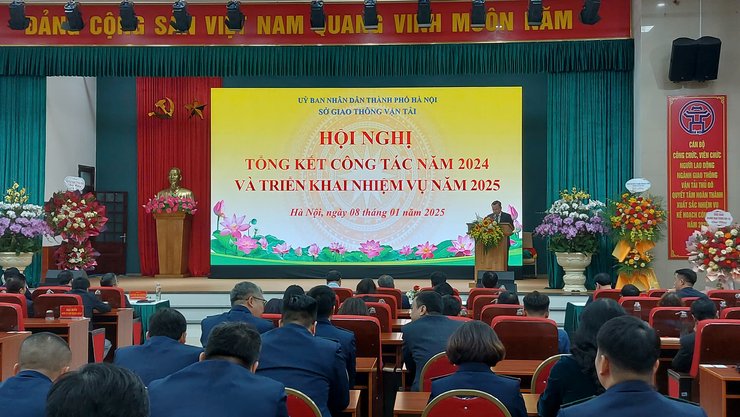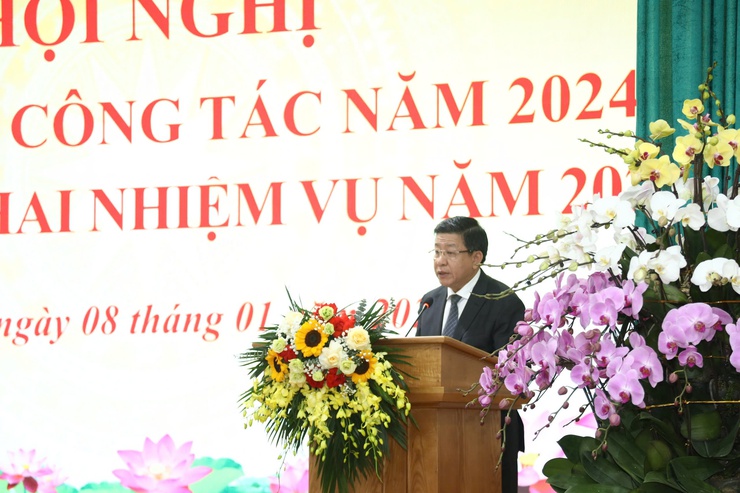In 2024, the Hanoi Department of Transport met several key targets, including an estimated budget revenue of US$8.95 million, surpassing its target of US$6.57 million by 136%. The department also achieved a 97% disbursement of its planned capital, and the public passenger transport rate was estimated at 19.5%.

Overview of the meeting.
Land allocated for transportation reached approximately 12.15%, and 99.85% of administrative procedures were resolved on or ahead of schedule, with 70.76% processed online at levels 3 and 4.
The department contributed opinions on draft resolutions, decrees, and circulars to concretize the Amended Capital Law, the Road Law, and the Traffic Order and Safety Law. It developed detailed plans for four resolutions related to transport to implement the Amended Capital Law. It advised the city to propose a resolution to the Hanoi People's Council on policies encouraging investment in charging infrastructure and public transport using electric and green energy, replacing provisions under Resolution No. 07/2019/NQ-HĐND.

Vice Chairman of the Hanoi People's Committee Duong Duc Tuan at the meeting.
The department coordinated the finalization of two master plans (revised General Planning and City Planning) for submission to the Prime Minister. It led efforts with relevant units to propose planning directions for the Ngoc Hoi station complex. Recommendations included reporting to the Prime Minister to approve adjustments to Hanoi's transport master plan through 2030, with a vision to 2050, and contributing feedback on national sector plans developed by the Ministry of Transport.
Traffic management was regularly implemented with synchronized, timely, and flexible measures that reduced congestion and traffic accidents while ensuring safety during political and cultural events. Thirteen of 33 congestion points were addressed. The department deployed 144 traffic inspection teams to manage flow at key intersections, completed the installation of 66 traffic signal systems, and piloted the operation of the Traffic Operations Center (TOC).
For 2025, the department set comprehensive targets: fully meeting annual tasks assigned by the Ministry of Transport, Hanoi Party Committee, People's Council, and People's Committee; exceeding budget revenue plans; achieving a public passenger transport rate of 20-22%; resolving over 99% of administrative procedures on or ahead of schedule; continually improving ISO 9001:2015 quality management systems; and maintaining and enhancing the Public Administration Reform Index (PAR Index).
Key focus areas include finalizing mechanisms and policies related to the sector, implementing approved proposals, and accelerating investment preparation and execution for critical transportation projects such as the underground section of Metro Line 3.1, Metro Line 5, and Metro Line 2 (Nam Thang Long – Tran Hung Dao). Other significant projects include the Ring Road 4 segments, Duong 02 Bridge, Northern Ring Road 3, Southern Trunk Road, National Highway 6 (Ba La – Xuan Mai), and major bridges over the Red River such as Thuong Cat, Tu Lien, and Van Phuc.
Speaking at the conference, Hanoi Vice Chairman Duong Duc Tuan commended the department for completing its 2024 tasks, noting its achievements in key indicators aligned with strategic goals. Tuan highlighted the department's clear identification of congestion as the primary challenge and its efforts to propose solutions to long-standing issues, including thorough planning and investment strategies.
Regarding planning, the department proactively advised the city to report to the Prime Minister for approval of transport master plan adjustments. For infrastructure investment, the department recommended the city approve key projects, including Northern Ring Road 3 and three major Red River bridges (Tran Hung Dao, Ngoc Hoi, and Tu Lien).
The Vice Chairman emphasized the department's role in guiding the city's approval of quality and timely projects, such as the Au Co – Nghi Tam Road and two steel overpasses at Mai Dich. He particularly praised the department's contributions to legal, planning, and sector-specific documents, including the comprehensive evaluation of the bus network, smart traffic initiatives, and public transport development using green and electric energy.
Despite achievements, the Vice Chairman noted remaining challenges, including low land use for transportation (12.13% versus the planned 20-26%), a public transport usage rate of 19.50% (compared to the 50-55% target), and delays in completing critical transport projects. The city's ring roads remain incomplete, radial roads are underdeveloped, and urban roads lack lateral connections.
The Vice Chairman stressed the priority of developing high-capacity public transport, particularly the urban rail network as the backbone of the system. While the city plans 15 urban rail lines totaling over 616.9 km, only 21.5 km (4% of the total) are operational, including the Cat Linh – Ha Dong Line (13 km) and the Nhon – Cau Giay Line (8.5 km).
He urged the department to focus on implementing four resolutions linked to traffic and congestion reduction as part of the Amended Capital Law in 2025. Based on the revised Capital and General Planning frameworks, he called for adjustments to the transport master plan, prioritizing urban and regional transport infrastructure development.
The department is tasked with continuing eight long-term solutions and six immediate measures outlined in its plans.